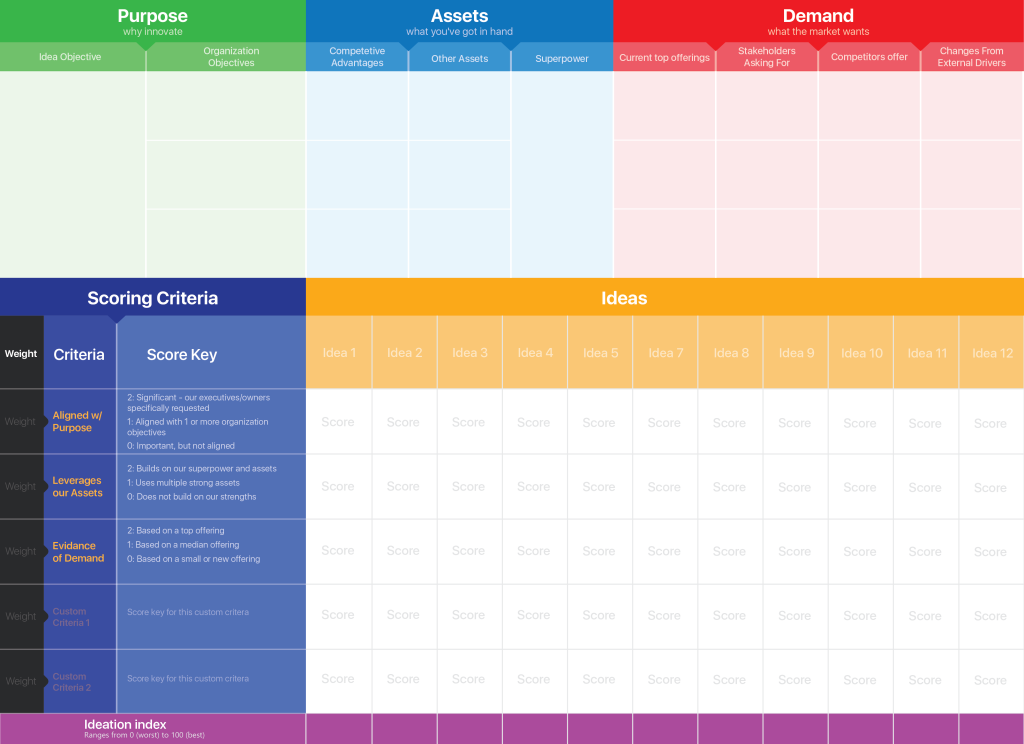
“We’ve been world-class at what we do for decades. But the world has changed and we need to adapt. How do we come up with ideas that are out-of-the-box and have high potential?”
-PixelEdge Client
Lots of people think the answer is: lock the senior leadership in conference rooms for months of meetings, creating vast piles of scenarios and slide decks. No! No! No!
The method below provides leaders at large organizations with a low-risk means to come up with quality ideas in just one day! Some ideas go on to have profound impacts on their financials.
- People:
- Senior leadership
- Staff with fresh experience, sometimes painful, from the field.
- Tools:
- Leverage the IdeaPAD to help you track everything you need on 1 page.
- Process: Set aside 1 day to…
- Build a PAD to launch your ideas from:
- (P)urpose: It’s hard to get somewhere if we haven’t communicated where it is! Senior leadership should clearly define the Objective of innovation and summarize the company’s current Strategic Priorities.
- (A)ssets: Great innovations always leverage your strengths. Document your company’s superpower, competitive advantages, and other assets.
- (D)emand: No market demand? Then you have a hobby, not a viable business idea. Evidence of demand comes from your current top offerings, items stakeholders keep begging for, and items your competitors offer. Demand can also arise from large external drivers – like when COVID radically changed the employment landscape.
- Ideate
- Give everyone 10 minutes to review these items and generate a list of ideas. We’re talking post-it note level descriptions here, no paragraphs or novels, please!
- Have everyone put their top ideas up for all to see.
- Score:
- Rate all the ideas against the first criteria listed on the IdeaPAD. This is when you give the ideas author a chance to explain the ideas a bit. I recommend you have everyone do their own independent and private scoring. Repeat the process for all criteria & ideas. Average up everyone’s scores to provide each idea a final score.
- Discuss & Decide:
- Take some time to discuss the top-scoring ideas and why they scored as they did. Take a moment to review why some of the low-scorers did poorly. Once complete, senior leadership should decide which ideas are worth further exploration.
- Build a PAD to launch your ideas from:
Results
- Viability identified ways to take their most successful program and scale it up 10x – which they did!
- Pathlight realized a curriculum they had always delivered as a bespoke, one-off solution could become an online training program that could reach a national audience.
- ERM identified multiple ideas that could have an existential impact on their business. One idea protecting them from new low-cost competitors and high-tech disrupters alike. Another idea has put them in the running to be #1 at helping the world’s largest companies reduce their carbon footprints.
Contact me to talk about our team helping you get the most out of this process.
Get your own IdeaPAD template for free
If you want to use the IdeaPAD yourself, the template is licensed under creative commons, which means you may use or modify it (with attribution) freely:
Acknowledgements
Paul Silva would like to give a huge thank you to:
- Stephen Brand for his original work that inspired this tool in the first place.
- Kelly Minton, co-founder of Paul Silva’s last startup, who helped evolve this tool from its earlier iteration to something much more powerful.
- Liz Slavkovsky for clarifying the language and helping us communicate to you.
- PixelEdge‘s Muhammad Awais Amjad for applying his design skills to make the IdeaPAD as attractive to look at as it is functional!